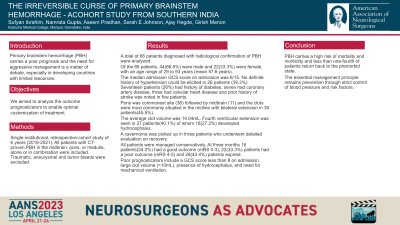The Irreversible Curse of Primary Brainstem Hemorrhage - A Cohort Study from Southern India
Friday, April 21, 2023


Sufyan Ibrahim, MBBS (he/him/his)
Research Fellow
Mayo Clinic Rochester
Rochester, Minnesota, United States
ePoster Presenter(s)
Introduction: Primary brainstem hemorrhage (PBH) carries a poor prognosis and the need for aggressive management is a matter of debate, especially in developing countries with limited resources. We aimed to analyze the outcome prognosticators to enable optimal customization of treatment.
Methods: Single-institutional, retrospective-cohort study of 6 years (2016-2021). All patients with CT-proven PBH in the midbrain, pons, or medulla, alone or in combination were included. Traumatic, aneurysmal and tumor bleeds were excluded.
Results: A total of 66 patients diagnosed with radiological confirmation of PBH were analyzed. Of the 66 patients, 44(66.6- %) were male and 22(33.3%) were female, with an age range of 29 to 93 years (mean 57.6 years). The median admission GCS score on admission was 6/15. No definite history of hypertension could be elicited in 26 patients (39.3%). Seventeen patients (26%) had history of diabetes, seven had coronary artery disease, three had valvular heart disease and prior history of stroke was noted in five patients. Pons was commonest site (36) followed by midbrain (11) and the clots were most commonly situated in the midline with bilateral extension in 30 patients(45.5%). The average clot volume was 14.04mL. Fourth ventricular extension was seen in 27 patients(40.1%) of whom 18(27.2%) developed hydrocephalus. A cavernoma was picked up in three patients who underwent detailed evaluation on recovery. All patients were managed conservatively. At three months 16 patients(24.2%) had a good outcome (mRS 0-3), 22(33.3%) patients had a poor outcome (mRS 4-5) and 28(42.4%) patients expired. Poor prognosticators include a GCS score less than 8 on admission, large clot volume (>10mL), presence of hydrocephalus, and need for mechanical ventilation.
Conclusion : PBH carries a high risk of mortality and morbidity and less than one-fourth of patients return back to the premorbid state. The essential management principle remains prevention through strict control of blood pressure and risk factors.
Methods: Single-institutional, retrospective-cohort study of 6 years (2016-2021). All patients with CT-proven PBH in the midbrain, pons, or medulla, alone or in combination were included. Traumatic, aneurysmal and tumor bleeds were excluded.
Results: A total of 66 patients diagnosed with radiological confirmation of PBH were analyzed. Of the 66 patients, 44(66.6- %) were male and 22(33.3%) were female, with an age range of 29 to 93 years (mean 57.6 years). The median admission GCS score on admission was 6/15. No definite history of hypertension could be elicited in 26 patients (39.3%). Seventeen patients (26%) had history of diabetes, seven had coronary artery disease, three had valvular heart disease and prior history of stroke was noted in five patients. Pons was commonest site (36) followed by midbrain (11) and the clots were most commonly situated in the midline with bilateral extension in 30 patients(45.5%). The average clot volume was 14.04mL. Fourth ventricular extension was seen in 27 patients(40.1%) of whom 18(27.2%) developed hydrocephalus. A cavernoma was picked up in three patients who underwent detailed evaluation on recovery. All patients were managed conservatively. At three months 16 patients(24.2%) had a good outcome (mRS 0-3), 22(33.3%) patients had a poor outcome (mRS 4-5) and 28(42.4%) patients expired. Poor prognosticators include a GCS score less than 8 on admission, large clot volume (>10mL), presence of hydrocephalus, and need for mechanical ventilation.
Conclusion : PBH carries a high risk of mortality and morbidity and less than one-fourth of patients return back to the premorbid state. The essential management principle remains prevention through strict control of blood pressure and risk factors.
